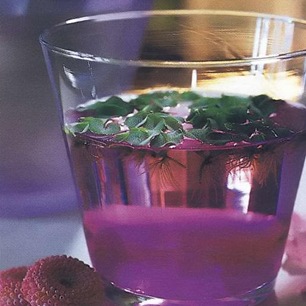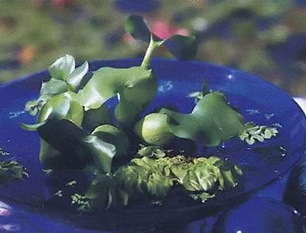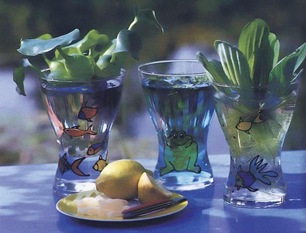In a stressful life, home ponds are attracting more and more attention. By the way, this is not only a way of relaxation, but also a fashionable, interesting and extremely useful endeavor.
A real oasis can be created by adding plants to the composition. For most of them (with the exception of succulents), the union with water is natural, and the benefits for humans are undoubted. The humidity and oxygen saturation of the air increases. This, in turn, increases the body's resistance to colds. And the combination itself beautiful greenery and water brings aesthetic pleasure.
Many types of popular indoor plants are suitable for decorating a home pond. Some of them can be used to create an “environment” - a spectacular green background for the water surface. The other part is suitable for growing directly in a pond (stream or fountain) - these are the plants that can add zest and help in creating a unique reservoir.
aquatic plants
aquatic plants- not necessarily those that grow under water. One of the main features of “hydrophilic” (water-loving) flora is the ability to anchor the root system in muddy soil and draw the maximum from it nutrients. In this case, the above-water or underwater position of the leaves and stems is of secondary importance. True, there are exceptions - plants that can only develop in the water column. But this is already a topic for an article about aquarium farming.

Let's take a closer look at what types of plants can be used to decorate a home pond, fountain or stream.
An oriental symbol of purity, the Lotus will decorate ponds decorated in a classic, minimalist style. It can become the highlight of an informal composition that imitates a corner of tropical nature. Moreover, it is not necessary to create a large reservoir; dwarf varieties have now been developed (for example, Baby Doll) suitable for small ponds.

General care requirements: plenty of light and regular, at least once every 3-4 weeks, fertilizing with mineral or organic fertilizers. For year-round flowering, Lotus needs 12 hours of daylight. This problem can be easily solved with the help of phytolamps.
This native of Africa is very popular in indoor floriculture. It can be found on window sills and shelves, but also better plant will feel like he's in a pond. A pot of Cyperus can and should even be immersed in water. By the way, this will completely solve the watering problem.
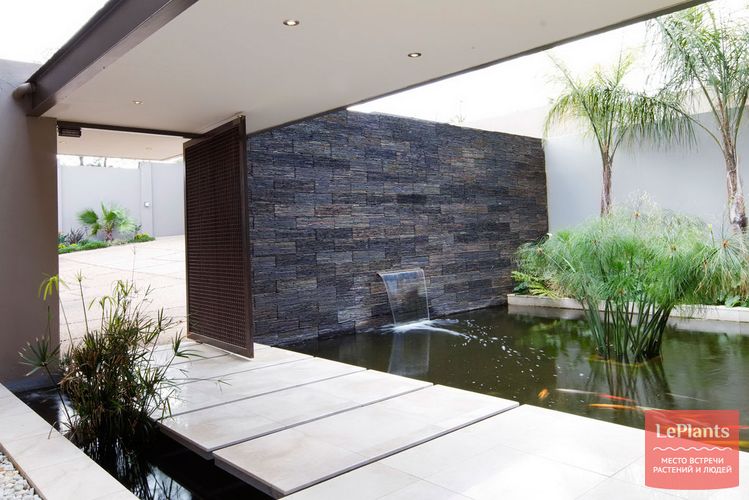
The plant is not demanding and grows well in both sun and shade. Thanks to the umbrellas of leaves located on long drooping stems, it will give the pond an exotic look. If desired, you can stimulate the appearance of new shoots. To do this, you need to regularly trim off any stems that have begun to turn yellow.
Anubias seems to be created for home ponds. Firstly, the plant does not suffer much from lack of lighting and can grow quite well even in the shade. Secondly, Anubias can be grown either completely under water or in shallow water, so that the foliage rises above the surface of the water. By the way, in the second case Anubias will build up much faster green mass.
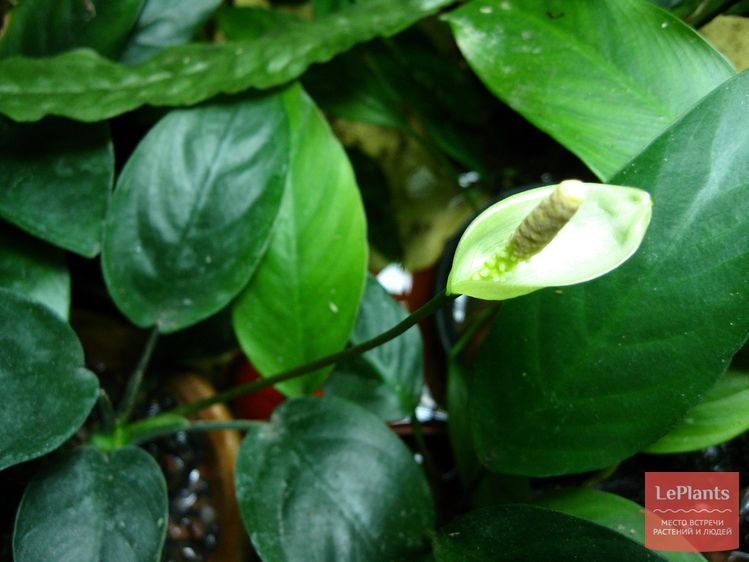
There are practically no secrets to growing this plant, famous in aquariums. Anubias is quite undemanding; it can even be attached to driftwood with its roots and create a very interesting composition. What you really need to take care of is the acclimatization of the beginner. A plant grown in air will take root more easily in water. But a plant grown in an aquarium or other body of water must be acclimated to the atmosphere carefully, for example, by gradually lowering the humidity (at first, keep it only in a greenhouse, followed by increasing the ventilation time).
This graceful perennial can be grown in a pot submerged in water. Isolepis will grow well in dim, diffused light - ideal property for a plant used to decorate home ponds.
The foliage of Isolepis is very thin and drooping, making the plant look gentle and elegant. True, if there is a cat in the house, it is better to find a safe place for the potty, inaccessible to the pet. If this is not done, the animal will sooner or later get to the plant, whose leaves it loves to eat.
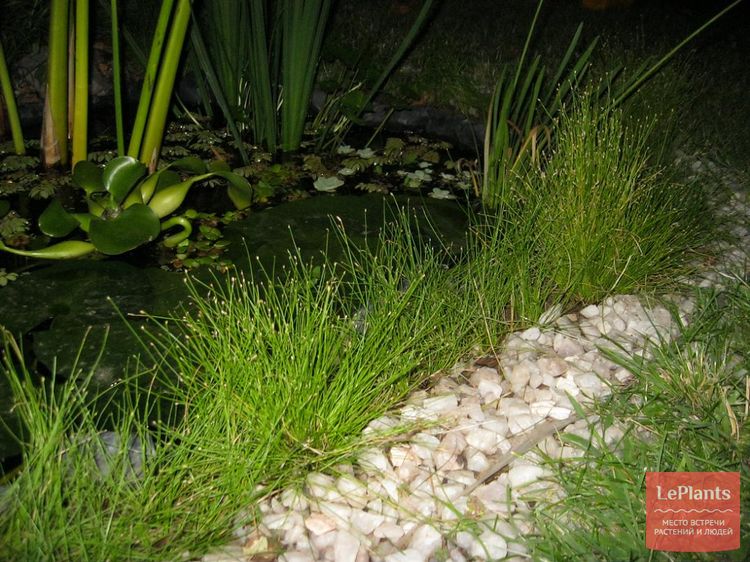
Isolepis is convenient because it signals the owner about the need for care. For example, the need for replanting is indicated by yellowed middle leaves.
If one of the walls of your home pond is transparent, you should take a closer look at Aponogeton Madagascar. This rather rare plant looks very unusual. It lacks leaf tissue, so the oblong leaves are a network of veins with cells of different diameters. Depending on the variety, they can grow from 3–4 to 55–60 cm in height.

It should be said right away: this plant will require special conditions content. He likes running water around +15–26°C. The plant will fit perfectly into the interior of a home waterfall or stream installed in a brightly lit place.
Orontium
Yellow, up to 15 cm in height, flower-cobs of Orontium look very original. Unlike other plants from the Araceae family, Orontium flowers do not have a spathe. The flowers look more like golden sticks, for which the plant received another, informal name - “Golden Club”.
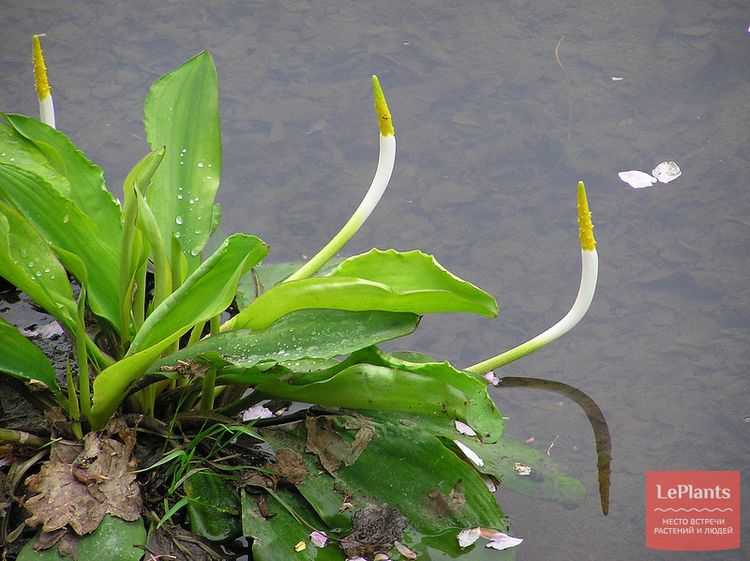
Orontium can be grown in both standing water and running water. It is better to plant the plant in a basket - this will prevent roots from growing all over the bottom. If Orontium is planted to a depth of less than 30 cm, the newly grown bluish-green foliage will rise above the water. If the depth is greater, the leaves will lie on the water surface like islands. Bright light And warm water will become the basis for successful development"Golden Club"
When placing plants in water and around a pond, you should be guided not only by design requirements, but also by the lighting needs of each of them.
Some aquatic plants can grow rapidly and crowd out other species. Remove seed pods and suckers regularly and use containers or baskets when planting to limit root growth.
Before planting in a pond, each plant should be checked for pests and diseases. Affected plants should not be planted; the disease can spread to healthy domestic species.
Don’t get carried away and completely fill your home pond with all kinds of plants. If they fit tightly, they will only interfere with each other. Remember: dense “thickets” combined with warm, stagnant air and high humidity are an excellent environment for the development of bacterial infections.
Plants in water instead of potted flowers? Why not! Tropical aquatic plants are now in vogue and can be presented impressively.
Suitable species
Pistia stratiotes, Eichhornia crassipes, Azolla caroliniana and Salvinia natans.
Our European duckweed (Lemna minor) also feels good in small vessels.
Place
Water and fertilizing
The water must settle and have room temperature. The depth of the “reservoir” must be at least 5 centimeters. Add water regularly.
Fertilizer for hydroculture, which is mixed with water in small doses, is well suited as a top dressing.
There is no way to get rid of foreign microalgae formed in water, so once every two to three weeks the vessels need to be washed and filled with fresh water.
Reproduction
If conditions are right, floating plants reproduce quickly. Water lettuce and water hyacinth cuttings are simply separated from the mother plant.
Wintering
In winter, when the light intensity drops, plants often lose their attractiveness. Try moving several specimens to the windowsill of a south-facing window for the winter. You can also buy special lamps for plants (these are often used to illuminate aquariums).
|
Fascinating underwater world Glass vessels, unlike natural bodies of water, allow one to see even the measles system of green swimmers. Shiny sea-green pebbles, green glass balls and a mermaid figurine accompany the entrance to the stage. writings, or water salad. |
Pink water Natural, harmless coloring agents from plant extracts and food colors are different colors. They can be used to tint the water in a transparent vase with a bouquet of flowers. Or you can, as here, place a floating salvinia and place accessories that match in color nearby. |
|
Mini pond in a green glass Original bouquet of water hyacinth, several shoots of Chinese miscanthus and flowering smooth iris (Iris laevigata) create the illusion of an aquatic mini-landscape. The bouquet is supported by two rush stems placed on the edges of the glass and tied at the ends, serving as a reliable clamp. |
Cute swamp Such a marsh plant as Cyperus, and will keep him company salvinia. Place the cyperus in the aquarium along with the pot, then it will be easier to clean the walls of the glass vessel. You can camouflage the pots with small pebbles and pieces of tuff. |
|
In contrast The dazzling blue of the glass bowl contrasts wonderfully with the lush greenery of the tropical aquatic plants floating in it. For water hyacinth Characterized by swollen, air-filled leaf petioles. Folds its leaves in a boat. |
Space for creativity Do you want to try your hand at painting? Take glass painting paints. Simple glass vases look much more elegant and cheerful with a painted frog “diving” to the bottom and schools of exotic colorful fish. Will willingly settle in such vases water hyacinth, salvinia And water salad. |
When talking about gardening, we rarely forget to mention aquatic plants. By creating a water garden, you can add personality to your garden project and complement it with unusual aquatic plant species. But many people don’t even know that aquatic plants can be successfully grown both outdoors and at home. Moreover, growing a water garden at home will require much less effort than in the case of an outdoor garden.
Home pond culture
To create a water garden, it is not necessary to purchase a huge container or aquarium; a regular pot for indoor plants may be quite suitable. This small indoor pond will decorate your room and diversify your usual set of indoor plants. And the best part is that the only need of these plants is fresh pure water. In addition, during the warm season, your aquatic plant can be taken outside if you so choose.
Selection of cookware
Almost any dish is suitable for aquatic plants: ceramic, plastic, porcelain or even metal (it is not advisable to use copper and brass). Just use your creativity, maybe some vessel lying around your house will suit you. If you don’t want to think about this, then you can take a simple glass jar. When using wooden pots, they are wrapped in a thick plastic bag, although it is better not to use wooden containers, as bacteria accumulate in them too quickly. In general, there are no wisdom or standards here; use the pots and dishes that you like best. 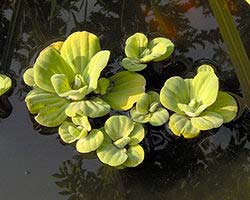
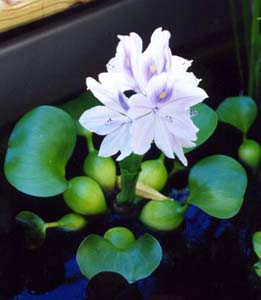 Types of aquatic plants
Types of aquatic plants
floating plants
To keep your floating garden healthy, you must prevent mud from forming. The best way to do this is to place it in your container (Eichornia) or (Pistia).
Oxygenic plants
They maintain the pH balance of water. Some of them grow on the surface of the water, others on the bottom. Examples: (anacharis, egeria densa), (fanwort, cabomba caroliniana).
Shallow water plants
These plants are located near the surface of the water. The water should only touch the soil of the plant. They grow in shallow water.
Deep sea plants
Plants such as Water lilies(water-lilies) require a lot of space and can only be planted in a bathroom or a decent barrel. The water should remain above their roots, so the vessel should also be quite deep (more than 30 cm). They also need a lot of space to breed. The advantages of this plant are that it prevents the spread of mud and keeps the water cool.
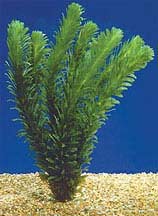 Artificial fountains
Artificial fountains
This is not a mandatory attribute of an indoor garden, but you can experiment. Installing them is quite simple. Moreover, they can perform the function of an oxygen generator, instead of oxygenic plants.
Hints 
Don't overdo it with lighting. Moderate lighting throughout the day is best for these plants. If there are fish in an aquarium with aquatic plants, then heat too much light can kill them.
- Do not place too many plants in one container.
- Protect plants from severe hypothermia.
- Do not use fertilizers frequently.
- If you have fish, make sure that the fertilizer will not harm them. Fertilizers are usually in the form of tablets and are partially buried in the soil. The amount of fertilizer is indicated on the package.
- Clean the container whenever plaque begins to form on its walls; it is convenient to use a brush for cleaning.
If you want to create a green corner in your apartment that has a luxurious and slightly mysterious look, you will need indoor plants that grow in water, that are not afraid of excessive moisture, but prefer it. When selecting such species, pay attention to the origin of the plant, if it natural place habitats are wetlands - such a flower will do.
The benefits of moisture-loving flowers for humans
Excessive dry air is harmful to our respiratory organs. Everyone feels this for themselves. Normal level The air humidity in the room will be between 40 and 70%. In winter, dryness becomes critical. Trying to correct the situation, we buy expensive air humidifiers that do not decorate our interior at all. But there is a wonderful way to achieve comfortable humidity in a natural and beautiful way - by growing semi-aquatic or aquatic plants.
Houseplants growing in water have a romantic, fantastic appearance and lush greenery. Such an area with lush greenery, and even in combination with well-chosen photo wallpapers, will create a real tropical kingdom in the apartment.
Any indoor flowers cleanse the atmosphere of the apartment and enrich it with oxygen. True, cacti and other succulents do this to a lesser extent. But tropical swamp plants have powerful photosynthetic activity. All physiological processes occur energetically in them, so they can supply us with oxygen and moisture to the maximum.
IN Lately Decorating the bathroom with living plants is becoming popular. Moisture-loving plants are ideal for this purpose. They will grow beautifully here. And while taking a shower or bath, you will feel as if you are on a tropical ocean coast.
Main representatives

This is the most famous and unpretentious of indoor aquatic plants. Its triangular, strong stems, growing in a bunch, end in a lush “fountain” of leaves spreading to the sides. For such a characteristic appearance Cyperus is often called “palm tree”. In fact, he belongs to the Osokov family. Its homeland is the wetlands of tropical Africa. Its closest relative is papyrus. And our pet is often called by a double name: Cyperus-Papyrus. This plant can be grown simply in a container of water. There is never too much water for him. The more it is, the more magnificent it grows. It is usually grown in flowerpots that stand in deep trays that are constantly filled with water.
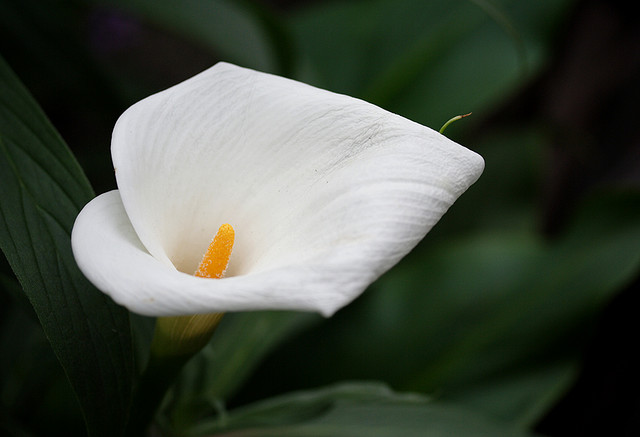
Calla, or calla lily
Second most popular indoor plant, preferring to grow almost submerged in water. This marsh plant came to us from subtropical regions South America. Its charming snow-white blanket surrounding the bright yellow ear of the upward-pointing inflorescence looks solemn and elegant. Pots with calla lilies, like cyperus, feel best when placed in trays filled with water. The popularity of the flower is associated not only with its magical beauty, but also with the significant plasticity of the plant. Calla lilies can also grow in conditions of relative lack of moisture. True, in this case you can’t count on lush flowering.
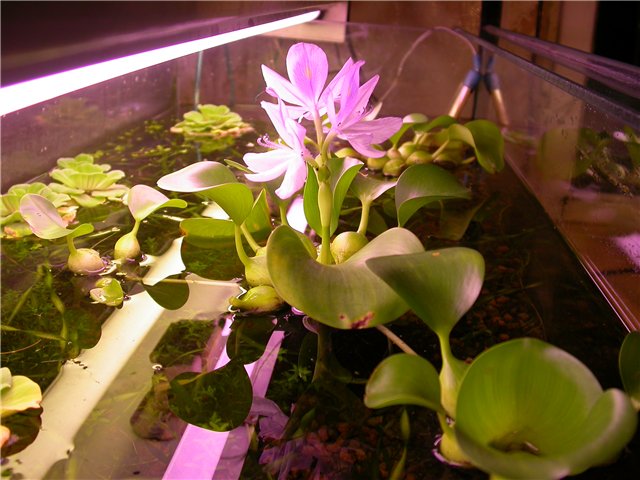
It is also called water hyacinth. She is also surprisingly unpretentious. The main condition for it is water. In nature, Eichornia grows in the tropical part of South America. However, thanks to its vitality, it now grows successfully in many warm climates around the world, earning it the nickname “water plague.” Eichornia is often used by aquarists, growing it on the surface of the water. It also enjoys well-deserved attention from flower growers. This indoor aquatic plant prefers to grow in wide, but not small, containers of water, which are placed in a warm place with sufficient lighting. Drafts are extremely undesirable. IN summer time When the conditions are most favorable for it, eichornia will delight you with graceful lilac flowers, indeed, reminiscent of hyacinths.
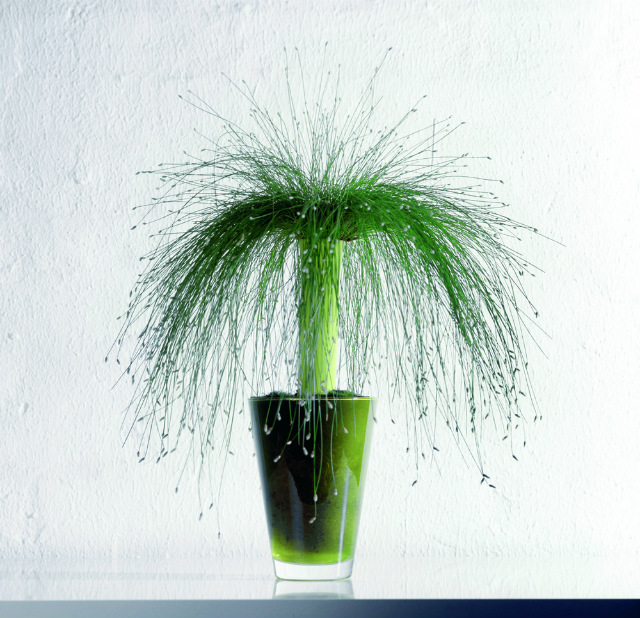
This plant is not distinguished by lush flowering, but its delicate thin thread-like leaves give it a peculiar charm. It is no coincidence that flower growers, touched by his airy appearance, gave him whole line affectionate names: “cuckoo tears”, “graceful isolepis”, “hair grass”. The young leaves of this reed first grow vertically. Gradually, becoming longer, they begin to bend, forming a lush bunch of thin green tubes with silvery lights of small rounded inflorescences at the tips. This allowed flower growers to humorously call this reed “fiber-optic grass.” It is for this reason that the flower looks most impressive in tall flowerpots standing in filled trays.

Many varieties of bamboo, especially low-growing varieties, are excellent for growing in water. But it does relatively well with less moisture. Maybe he can put up with some lack of light. Bamboo is very plastic both in terms of growing conditions and the ability to give it different shapes. It grows quickly, creating fancy bushes. There are a lot of varieties of bamboo; you can choose both low-growing and powerful plants.

This species is completely undemanding to growing conditions. The only thing he needs is large quantities- water. The modest appearance of the plant is not a reason to refuse to grow it in our homes. It perfectly complements compositions with calla lilies or bamboo. It is good to use for decorating a loggia or veranda. And in the summer, pots with calamus can be placed in a decorative pond at the dacha or in the garden. In any place this plant will delight not only with its bright greenery, but also pleasant aroma, reminiscent of a tangerine.
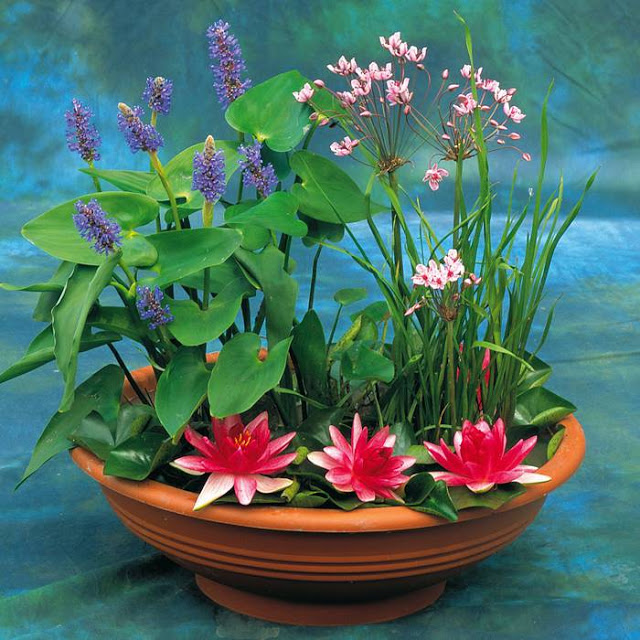
This is a very showy plant with shiny leaves and flowers of lilac, blue or white. Her homeland is Southern, Central and North America, from tropical to warm temperate parts. The flower grows in shallow areas of rivers and lakes. Therefore, when cultivating pontederia, it must be planted in water to a depth of about 8 cm. The height of its bushes reaches half a meter. In summer, purple spike-shaped inflorescences appear among the bright heart-shaped leaves. Flowering continues all summer until almost half of autumn. Then the pontederia begins a period of rest, but its luxurious bushes do not lose their attractiveness.
Based on these moisture-loving plants, you can create various compositions that will decorate your home, make it cozier and more comfortable. There is no need to try to buy all of them; just choose three or four types you like. They will make you happy all year round. Just don't forget to add water.


